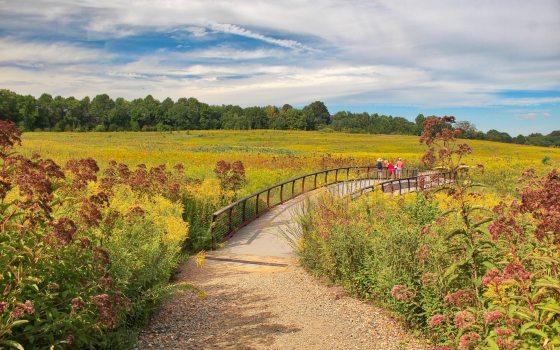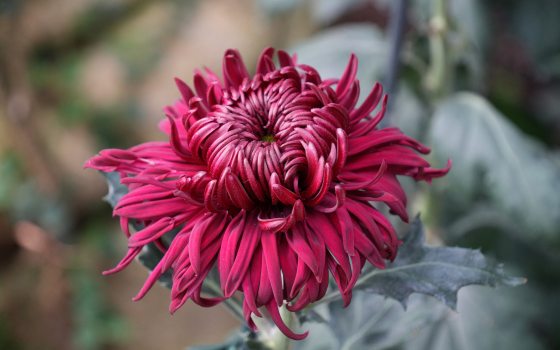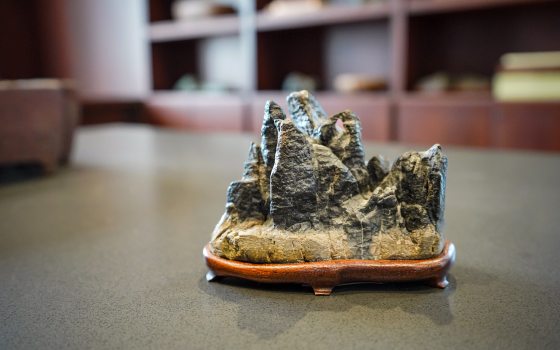Ten years ago, we opened the gates to an expanded garden—and one that’s markedly different from every other garden at Longwood. At 86 acres, the Meadow Garden joins horticulture to ecology on a landscape scale, reflecting relationships between people, nature, and the historic landscapes of the region—and bringing joy and wonder with its ever-changing beauty and biodiversity. Today, we look back on the Meadow Garden’s history, celebrating its impact on not only our Gardens, but our entire region—and we look forward to the many beautiful tomorrows this Pennsylvania Piedmont landscape promises. We also share with you just how we’re marking the occasion with strolls, talks, and opportunities for exploration on September 20.
Strolling the Meadow Garden’s paths today, one might not guess that this natural landscape is the product of decades of thought and effort. The seed of today’s garden was planted in 1969 by Longwood scientists who began adding native wildflowers to a hay field just north of the Italian Water Garden that had long been part of Longwood’s farmlands. Famed mineralogist and botanist Dr. Edgar Wherry consulted on the project to bring wild species of woodland, pond, marsh, and meadow settings.
In 1975, Longwood’s first director Russell J. Siebert envisioned the area as a naturalized meadow, where Longwood would “encourage a succession of native and naturalized wildflowers and grasses naturally occurring in this valley to bloom and seed throughout the entire growing season” that would “demonstrate to the community, the visiting public and to students the value of this kind of ‘open’ land.” A Managed Meadow planning committee guided these efforts, including the addition of thousands of young trees to the northern ridgeline to screen roads and buildings. In 1985, prescribed fire was first used to maintain the Meadow Garden’s open habitats.
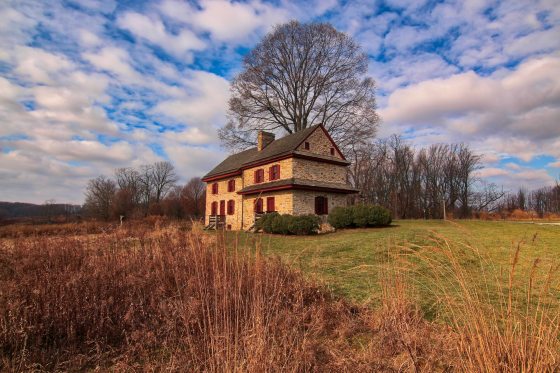
The Webb Farmhouse, which has stood on the Longwood property since the early 1700s, was restored in 2014 to serve as a gallery space, showcasing the evolving seasonal beauty of the Meadow Garden and the story of the people who have inhabited and influenced the land. Photo by Scott Hummel.
As the wildflowers spread, and as the importance of conserving historic landscapes and native species became more apparent over time, a new kind of sustainable garden began to be imagined. A collaboration with the Pennsylvania Department of Transportation moved Route 52 from a narrow, twisting route along a stream to a wide road with a bridge for wildlife to pass beneath—enabling meadows accessible to guests to double in size. Longwood engaged Jonathan Alderson Landscape Architects, who took inspiration from naturally occurring patterns and accentuated them to create experiences that celebrate the Meadow Garden’s ever-changing nature. With the expanded Meadow Garden’s 2014 opening, new paths, pavilions, and artistic touches drew guests out into the spacious rolling terrain. Former pastures lying outside the new Meadow Garden were reforested with diverse native trees.
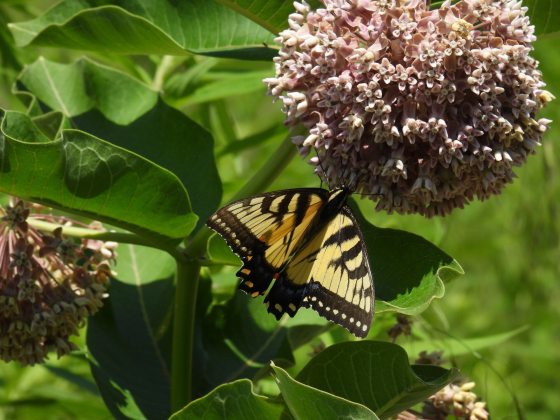
Eastern tiger swallowtail butterflies (Papilio glaucus) are a familiar sight in the Meadow Garden. As adults, they depend upon the nectar resources provided by flowers like this common milkweed (Asclepias syriaca). Photo by Candie Ward.
Today, the Meadow Garden is cared for by our Land Stewardship and Ecology team—an integrated group of scientists and land stewards who adaptively manage Longwood’s 750 acres of natural areas for both beauty and biodiversity. Using the tools of the gardener’s toolbelt, the field ecologist’s truck, the farmer’s equipment shed, and technology’s latest developments, this small but mighty team collaborates across the Gardens and engages in research and stewardship to test and innovate approaches to sustainable land management. We renew the Meadow Garden’s full-sun-loving plant communities with prescribed fire—with the enthusiastic help of students willing to go through rigorous training.
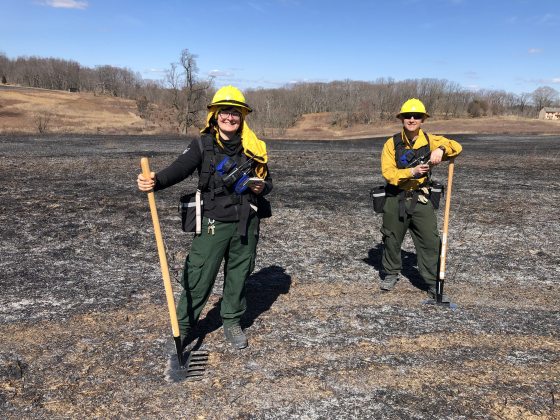
Research Specialist Kristie Lane Anderson and Senior Land Stewardship Technician Ryan Pardue stand in the eastern Meadow Garden just after an early spring burn. Because meadows—like other grassland systems—require frequent ecological disturbance to keep trees from shading them out, we apply prescribed fire on a regular rotation. Perennial plants and seeds hide just below the surface, waiting to sprout. Photo by Lea Johnson, Ph.D.

Like the Eastern Bluebird, Tree Swallows like these historically nested in abundant tree holes in old forests. More than 200 nest boxes like the one shown here are tended by Longwood volunteers to support the nesting success of these birds. Photo by Hank Davis.
Intrepid, all-terrain volunteers assist in this work—checking nest boxes, observing when hundreds of species of wildflowers bloom, mapping and pulling invasive species, measuring trees, recording scientific data, caring for plantings, and tending beautiful native plant displays along the Meadow Garden’s paths. Together, we support the health and vigor of a habitat that has become rare in our region.
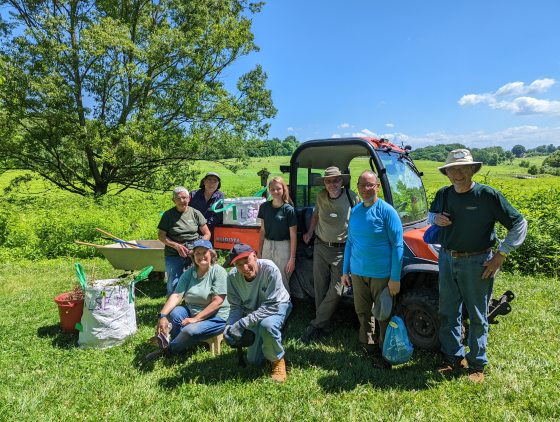
Meadow Garden volunteers keep the entrances, pavilions, and other hotspots of floral display looking good across the Meadow and Forest District—but that’s not all! They also beat back invasive species, help with new plantings, and tend to the plants as they grow. Photo by Pandora Young.
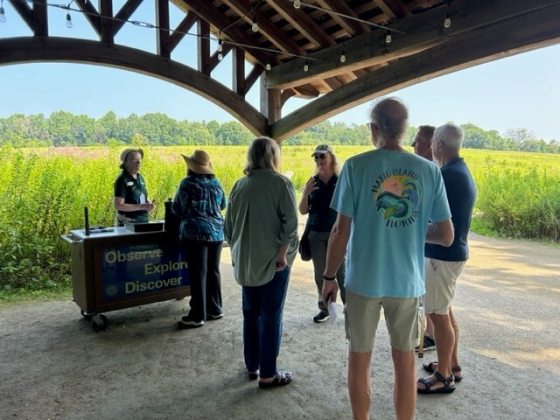
Docents share their knowledge at a cart in the Hourglass Pavilion. Photo by Jeanette Corgnati.
As we celebrate the tenth anniversary of the opening of the expanded Meadow Garden, we are also celebrating the completion of a new plant community inventory of our natural areas as part of the Land Stewardship and Ecology program’s Ecological Baseline Study. We have catalogued and described more than 200 distinct plant communities across our natural areas, installing permanent research plots in each one so that we can understand how our ecosystems respond to change over time. This will help us to understand what management practices work best, and also give us important information about how our plant communities are responding to broader environmental change—helping us to respond in turn, and to plan for the future. In the Meadow Garden alone, we have mapped and counted every species in 17 different plant communities! Today the Meadow Garden blooms with hundreds of species of native plants found in the tall grasslands and wet meadows native to our region, supporting intricate relationships with wildlife that depend upon them in every season.
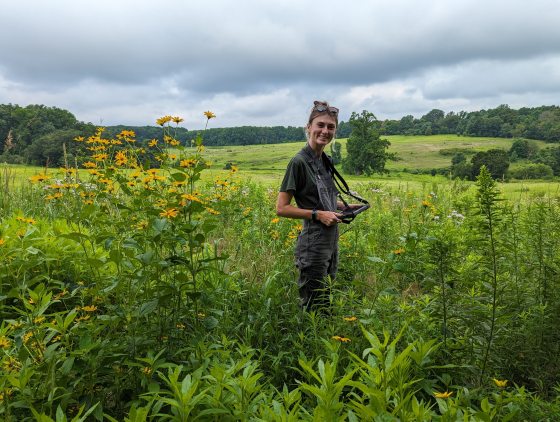
Land Stewardship and Ecology Intern Elaina Haas collects scientific data describing the plant communities of the Meadow Garden as part of the Ecological Baseline Study. Research helps us to understand how our ecosystems change over time and to plan for their future. Photo by Pandora Young.
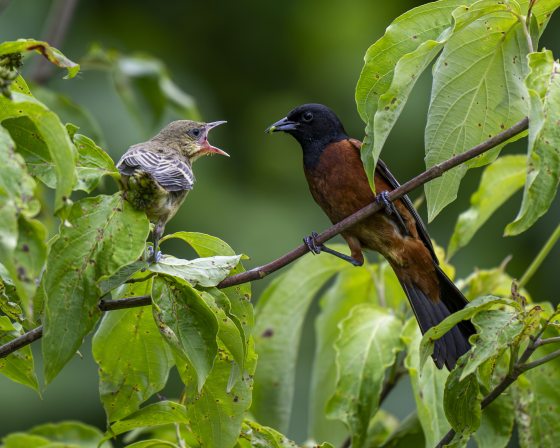
A fledgling orchard oriole opens up wide for a meal from a parent. The Meadow Garden hosts diverse native plants, which support a diverse insect community, which support a thriving bird community. Photo by Hank Davis.
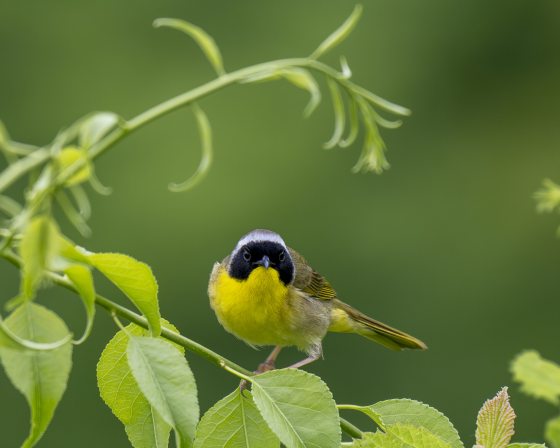
The common yellowthroat is one of more than 150 different bird species that flock to the Meadow Garden, which offers a buffet of different resources for different wildlife. This migratory warbler enjoys open areas with low, dense vegetation where there are tasty small insects to eat. Photo by Hank Davis.
From the redbuds and pussytoes of spring through the pink and orange milkweeds of mid-summer to the explosion of purple and yellow goldenrods and Joe-Pye-weeds that are the season’s last hurrah, the Meadow Garden not only provides a feast for the senses for our human guests—it also provides nectar and host plants for pollinators. Caterpillars munching on the Meadow Garden’s leaves are the best baby food for many birds. As flowers turn to seeds, they feed goldfinches and other seed-hungry birds throughout the season, with some like winterberry holly along the Meadow Garden’s stream providing fruits into winter.
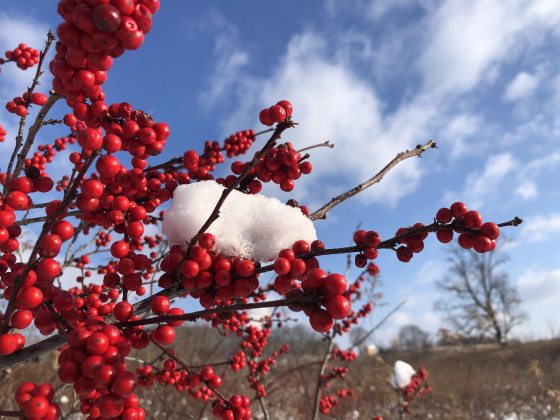
Winterberry holly (Ilex verticillata) loses its leaves in winter, leaving bright red berries visible for people—and birds—to enjoy. Winterberries are a winter food for birds and other animals in the Meadow Garden, where we have planted them in abundance along the stream. In summer, their leaves shade and cool the water. Photo by Lea Johnson, Ph.D.
When the cold season arrives, leaf litter and dry stems provide cover and homes for overwintering animals, from foxes to native bees. And when spring arrives again, the cycle continues—year after beautiful year.
Editor’s note: Join us as we celebrate the tenth anniversary of our expanded Meadow Garden with a variety of strolls, talks, and opportunities to experience all this beautiful space means to Longwood—and to our region. Learn more about our Meadow Garden anniversary activities, taking place in our Gardens on September 20—and join us in this always-remarkable space.
